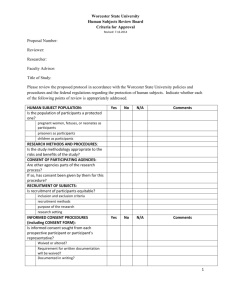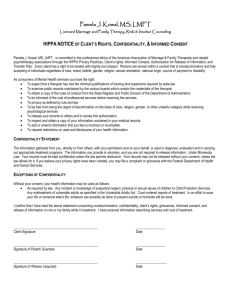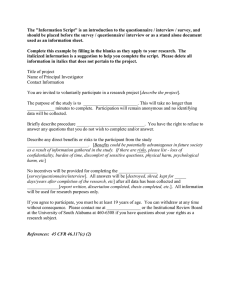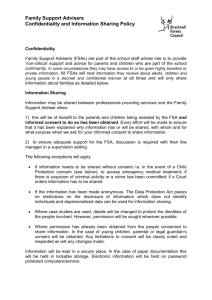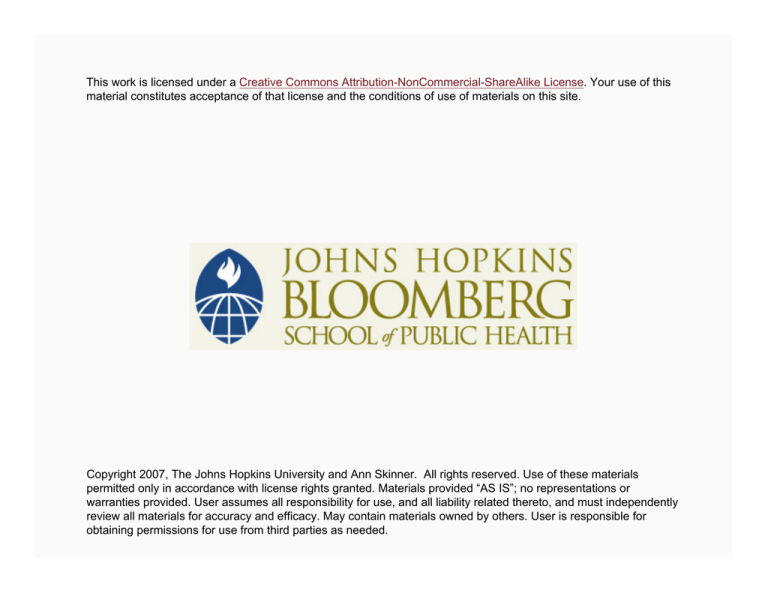
This work is licensed under a Creative Commons Attribution-NonCommercial-ShareAlike License. Your use of this
material constitutes acceptance of that license and the conditions of use of materials on this site.
Copyright 2007, The Johns Hopkins University and Ann Skinner. All rights reserved. Use of these materials
permitted only in accordance with license rights granted. Materials provided “AS IS”; no representations or
warranties provided. User assumes all responsibility for use, and all liability related thereto, and must independently
review all materials for accuracy and efficacy. May contain materials owned by others. User is responsible for
obtaining permissions for use from third parties as needed.
Ethics in Health Services Research
Ann Skinner, MSW
Johns Hopkins University
Section A
Overview
Belmont Report Principles
Respect for persons
− Individuals should be treated as autonomous agents
− People with diminished autonomy are entitled to
protection
4
Belmont Report Principles
Beneficence
− Do no harm
− Maximize possible benefits and minimize possible harms
Justice
− The benefits of the research should accrue to those who
bear the burden of participation
5
Impetus for the Belmont Report
Medical experiments conducted by Nazi physicians in the
1930s and early 1940s
− Lack of autonomy
− Inhumane treatment
− Research findings intended for others
6
Nuremberg Code
Nuremberg Code, 1947
− Informed consent without coercion
− Human experiments based on animal research
− Expected results should justify the research
Nuremberg Code, 1947
− Scientists must be qualified
− Physical/mental suffering avoided
− No expectation of disability or death from the research
7
Declaration of Helsinki
Declaration of Helsinki (drafted 1953, adopted 1964)
− Ethical principles for “therapeutic” and “non-therapeutic”
research
8
Other Events
The Milgram Study (published 1963)
− Deception
The Tuskegee Study (started 1932, exposed 1972, stopped
1973)
− Informed consent
− Physical harm
− Deception
9
Events after Tuskegee
1974—National Research Act
− Institutional review boards
− Informed consent
1979—The Belmont Report
1981—Code of Federal Regulations
1991—Common Rule
10
Federal Oversight
Office of Human Research Protections
− Structure and function of IRBs
Food and Drug Administration
− New drugs and devices
11
Section B
Human Subjects Protection Program
Objectives of Human Subjects Protections Program
Risks balanced by benefits
Minimize risks of harms
13
Types of Harms
Physical
Psychological
Legal
Drug side effects
Adverse surgical outcomes
Injury
Emotional distress
Anxiety
Relapse
Precipitation of depression
Arrest, prosecution
Civil or criminal liability
14
Types of Harms
Social
Economic
Embarrassment
Ostracism
Stigma
Loss of status
Retribution
Loss of job or income
Loss of insurance/insurability
Reduced employability
Financial loss
15
Harm/Reduction of Risk of Harm
Harm
Many unpleasant side effects
Distress from questions about
suicide
Reduction of Risk of Harm
Frequent monitoring, long-term follow-up
Eliminate sensitive questions
Warn about sensitive items and ability not
to answer
Make counselor available
Embarrassment from questions Anonymous participation
about relations with co-workers Confidentiality protections
Prosecution for illegal activities Confidentiality protections
Delete questions
Certificate of Confidentiality
16
Types of Benefits
Direct benefits—research subject gets something from
participation that he/she would not get otherwise
Examples—access to medical care information from a blood
test, chance to talk about an important issue, learn a new skill
17
Types of Benefits
Societal benefits
− Contribution to basic scientific knowledge
− Development of new product, technique
− Information for decision-making
18
Harm/Reduction of Risk of Harm
Harm
Many unpleasant
side effects from
study drugs
Reduction of Risk
Frequent monitoring
Likely Direct
Benefit
Access to a new drug
treatment
Long-term follow-up
Likely Society
Benefit
Low—drug similar to
existing drugs and no
better side effects
Access to medical care
Referrals for other health
problems
Distress from
questions about
suicide
Embarrassment
from questions
about relations
with co-workers
Prosecution for
illegal activities
Eliminate sensitive questions
Chance to talk about
problem
Warn about sensitive items and
Access to counseling
ability not to answer
Make counselor available
Anonymous participation
Chance to talk
Moderate—more
effective, fewer side
effects
High—new drug
Low—questions don’t
directly address
hypotheses
Moderate—will help
explain important
contributory
relationships
Confidentiality protections
Confidentiality protections
Delete questions
Chance to talk
High—questions directly
measure independent or
dependent variables and
will advance scientific
knowledge
Certificate of Confidentiality
19
Section C
Informed Consent and Vulnerable Populations
Informed Consent
Process
− Recruitment
− Explanation of research
− Confirmation of understanding
− Documentation of agreement
21
Elements of Informed Consent
Who is doing the research
Purpose
Procedures
Duration of participation
22
Elements of Informed Consent
Risks or discomforts
Anticipated benefits
Confidentiality protections
Assurance of voluntary participation
23
Privacy and Confidentiality
Privacy—limited access to an individual and to information
about that person
Confidentiality—how access to and use of private
information is structured
24
Potential Breaches of Confidentiality
During data collection
− Knowledge of participation
− Overhearing interviews
− Access to names, identifiers
Data protection during and after analysis
− Identifying information
− Paper storage
− Computer security
25
Vulnerable Subjects
Ability to give informed consent
− Children—assent and parental permission
− Cognitively impaired—determination of ability to give
consent, proxies
− Comatose or unconscious patients—proxies
26
Vulnerable Subjects
Voluntary consent/absence of coercion
− Prisoners
− Students
− Employees
Heightened risk
− Pregnant women
− Sick people
27
Vulnerable Subjects
Justice (equitable distribution of risks, benefits)
− Women
− Elderly
− Racial/ethnic minorities
− Economically disadvantaged
− Terminally ill people
28
Institutional Review Board
At least five members
At least one non-scientist
At least one person unaffiliated with organization
Experts in areas of research conducted by organization
29
Types of Review
Exempt—no risk
− Determination made by IRB chair
Expedited review—minimal risk
− Complete review by IRB chair or one designated member
Full committee review—greater than minimal risk
− All committee members conduct review
30
Criteria for Approval
Risks to subjects are minimized
Risks are reasonable in relation to any anticipated benefits
Selection of subjects is equitable
Informed consent will be sought
Informed consent will be appropriately documented
Privacy is protected
When appropriate, safety monitoring is provided
Appropriate safeguards are in place if vulnerable subjects are
involved
31
Weighing the Science
A poorly designed study will not answer the research
question/hypotheses and is therefore unlikely to have a
benefit
A well-designed but high risk study that addresses a minor
issue is likely to have benefits of less weight than the risks
32
Continuing Review
At least once a year
Review for . . .
− Any adverse events or problems
− Any changes in the risk/benefit balance
− Any changes in procedures
33
Section D
Health Insurance Portability and Accountability (HIPAA)
HIPAA Privacy Rule
Health Insurance Portability and Accountability Act of 1996
Privacy regulations effective April 14, 2003
New, specific rights to individuals about their health
information
Requires covered entities to use and disclose protected
health information only in permitted ways
35
Protected Health Information (PHI)
About an individual’s health, treatment, billing/payment for
services
About people who are alive or deceased
In any form—paper, electronic, recorded, spoken
36
Examples of PHI
Patient visit for health problem treatment
− Name, address, phone number
− Diagnosis
− Department and doctor names
− Test results
− Billing data
− Any linking identifiers
37
Examples of PHI
Research subject
− Name, address, etc.
− Results of tests performed as part of trial
− Questionnaire responses
38
Covered Entity
Providers that transmit PHI electronically
Health plans
Clearinghouses that receive PHI
Examples—Johns Hopkins School of Medicine, Johns Hopkins
Hospital, Johns Hopkins Health Plan
JHSPH is a “hybrid entity”
39
PHI from a Covered Entity Can Be Used in Research When . . .
Authorization is obtained from study subject or . . .
A waiver is obtained from IRB or privacy board
40
Authorization
What information will be used/collected
Who will use/disclose information
Why information is needed and how used
Who from outside will see information
That information may not be protected if shared with others
When authorization ends
Ability to cancel permission
41
Waivers
Waiver of authorization
− Minimal risk to privacy
− Adequate protection of identifiers
− Plan to destroy identifiers
42
Waivers
Waiver of authorization
− Assurance that . . .
X Research cannot be conducted without waiver AND
X Research cannot be conducted without PHI
Partial waiver of authorization to undertake recruitment
43

